


Copper redox and coordination chemistry
Copper is one of the most interesting transition metals for the home chemist. It can be made to appear in numerous coordination complexes, both at oxidation state +2 and oxidation state +1. Copper also can easily be reduced to the metallic state.
In this set of experiments, copper is brought into solution as a copper (II) complex, which is reduced to copper (I) in a strongly alkaline environment. This experiment shows, that copper (I) ions are coordinated by ammonia at lightly alkaline pH, at very high pH, copper (I) is precipitated as bright yellow hydrous copper (I) oxide. With a suitably strong reductor, this can be further reduced to metallic copper.
![]()
![]() Required
chemicals:
Required
chemicals:
-
copper sulfate
- dilute ammonia, 5%
- sodium hydroxide
- sodium sulfite
- sodium L-ascorbate
- sodium dithionite
![]() Required
equipment:
Required
equipment:
-
test tubes
-
burner or propane torch for heating
![]() Safety:
Safety:
- Copper salts are moderately toxic.
- Dilute ammonia is irritating for the skin. Concentrated ammonia is caustic and has a strong choking odor.
- Sodium dithionite is a skin irritant and it is unstable in neutral and acidic solutions, giving off pungent sulphur dioxide.
- When solid sodium hydroxide is dissolved in water, then quite some heat is produced. When a very small amount of water is used, the liquid may sometimes boil and splash.
-
 Sodium hydroxide
is very caustic. A splash in the eye of a solution of sodium hydroxide may
lead to blindness! When sodium hydroxide or its solution comes on the skin, rinse with
water, until the slippery feeling disappears. Do not wait with this, do
this immediately.
Sodium hydroxide
is very caustic. A splash in the eye of a solution of sodium hydroxide may
lead to blindness! When sodium hydroxide or its solution comes on the skin, rinse with
water, until the slippery feeling disappears. Do not wait with this, do
this immediately.
![]() Disposal:
Disposal:
- The copper waste should not be flushed down the drain. Solid copper waste can be wrapped in a piece of paper and should be kept aside for proper disposal.
![]()
Preparation of a copper (II) complex in ammonia
This experiment consists of a sequence of three experiments with different reductors of increasing strength. For each of the experiments, a solution of copper (II) in dilute ammonia is prepared.
First, a 0.5 M copper sulfate solution is prepared and to this, an excess amount of dilute ammonia (5% by weight) is added. The copper sulfate solution and the deep blue solution, obtained after adding excess dilute ammonia, are shown in the two pictures below.
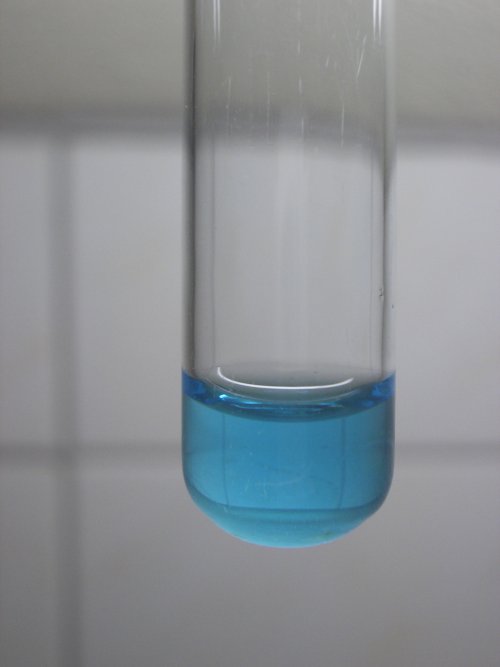
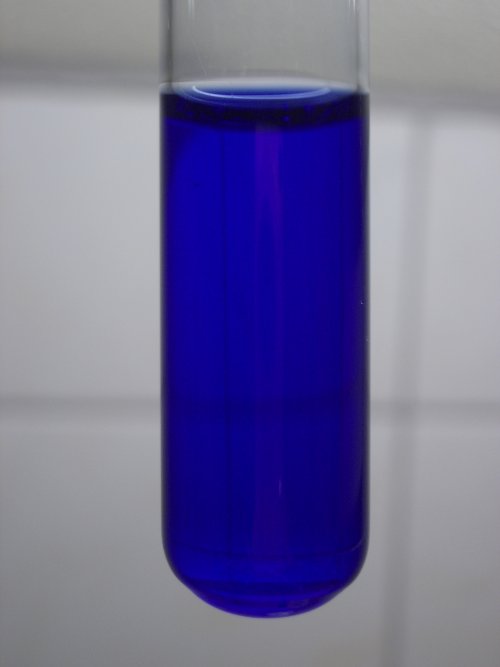
The deep blue solution is used as the starting point for each of the three experiments, described below. This solution was prepared three times in the same way, once for each of the three experiments described below.
![]()
Reaction of tetrammine-copper (II) complex with sulfite
![]() A spatula full of sodium sulfite is added to the deep blue
liquid with the tetrammine-copper (II) complex. An excess amount of sodium
sulfite is used. When this solid dissolves, then the liquid becomes much darker.
The bright saturated color also becomes somewhat less saturated. The liquid gets
a dark somewhat dull blue color.
A spatula full of sodium sulfite is added to the deep blue
liquid with the tetrammine-copper (II) complex. An excess amount of sodium
sulfite is used. When this solid dissolves, then the liquid becomes much darker.
The bright saturated color also becomes somewhat less saturated. The liquid gets
a dark somewhat dull blue color.
![]() When the
liquid is heated, then the color of the liquid shifts towards green. The liquid
remains very dark, but with some effort, one can see that the liquid is dark
green instead of dark blue.
When the
liquid is heated, then the color of the liquid shifts towards green. The liquid
remains very dark, but with some effort, one can see that the liquid is dark
green instead of dark blue.
![]() On
cooling down, the color shifts back to blue.
On
cooling down, the color shifts back to blue.
The following three pictures show the liquid, just after adding and dissolving of the sodium sulfite, after heating close to boiling, and after cooling down again. The last picture is with reflected light from inside the test tube and this shows the blue color of the dark liquid more clearly.
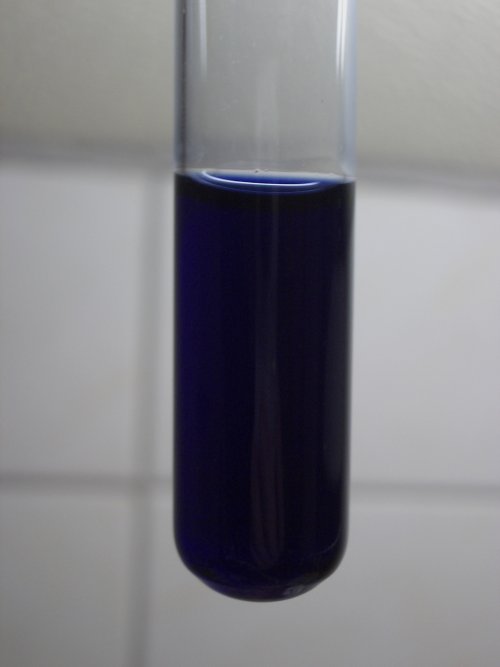
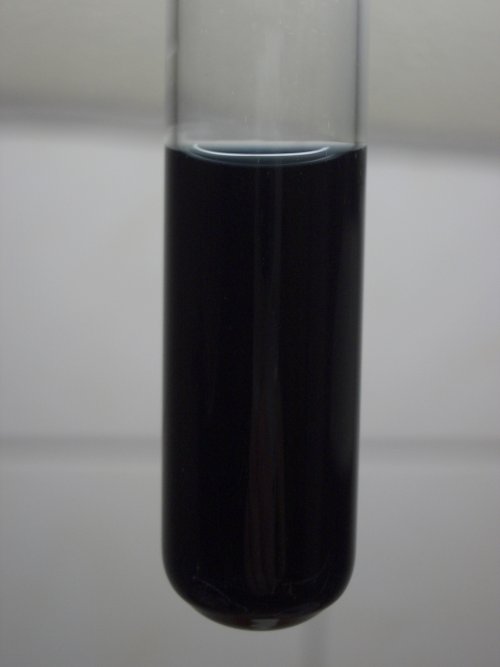
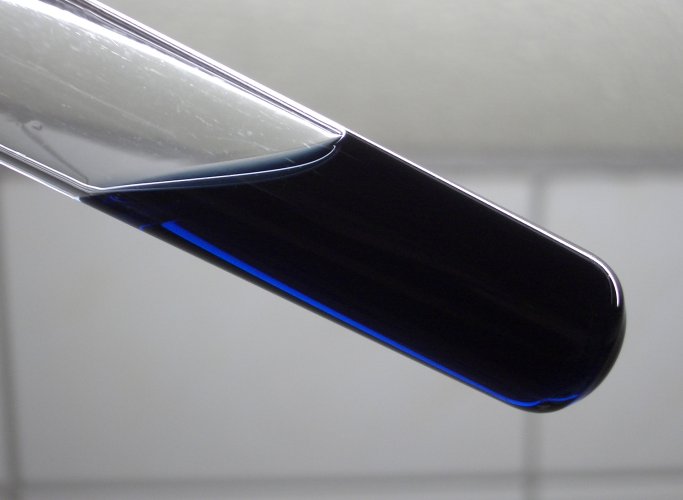
This experiment shows that sulfite is not capable of reducing the tetrammine copper (II) complex to a copper (I) complex, but it shows formation of a new complex, which changes color reversibly on heating and cooling down.
![]()
Reduction of copper (II) complex with L-ascorbate
![]() A new
preparation of the deep bright blue tetrammine copper (II) complex is used for
this experiment. To this, some sodium L-ascorbate is added. When the solid is added, then it quickly dissolves and the liquid
turns yellow quickly. The reaction is fast and complete. The change of color is
quite remarkable.
A new
preparation of the deep bright blue tetrammine copper (II) complex is used for
this experiment. To this, some sodium L-ascorbate is added. When the solid is added, then it quickly dissolves and the liquid
turns yellow quickly. The reaction is fast and complete. The change of color is
quite remarkable.
The left picture shows the liquid before adding the sodium L-ascorbate, the right picture shows the liquid after adding the sodium L-ascorbate.

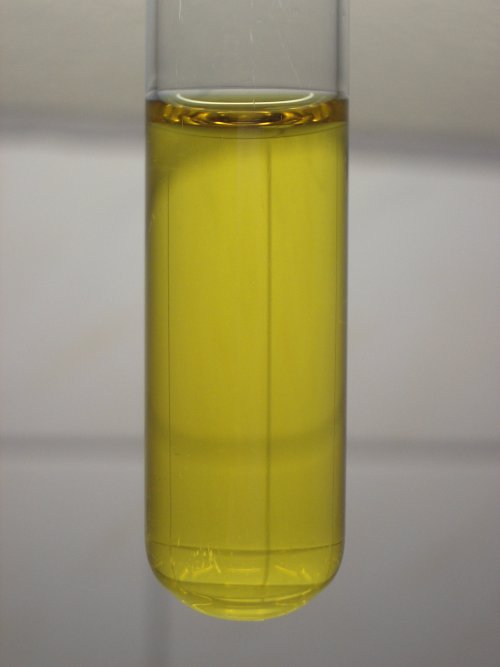
The yellow color may be a copper (I) complex, but it may also be oxidized ascorbate. More investigation of the reaction is necessary.
![]() The yellow liquid is stable. It does not change on storage
(at least not within an hour or so) and when it is heated, it remains yellow and
clear.
The yellow liquid is stable. It does not change on storage
(at least not within an hour or so) and when it is heated, it remains yellow and
clear.
![]()
Reduction of copper (II) complex with dithionite
![]() This is
the experiment with the strongest reductor. Again, a new preparation of
the deep bright blue tetrammine copper (II) complex is used for this experiment.
Now, some solid sodium dithionite is added to the liquid and the test tube is
shaken. This results in formation of a colorless liquid. The reaction is fast
and complete. The part of the liquid, which is in direct contact with air, becomes blue again. The
layer, just below the surface is blue and the liquid, sticking to the glass also
is blue.
This is
the experiment with the strongest reductor. Again, a new preparation of
the deep bright blue tetrammine copper (II) complex is used for this experiment.
Now, some solid sodium dithionite is added to the liquid and the test tube is
shaken. This results in formation of a colorless liquid. The reaction is fast
and complete. The part of the liquid, which is in direct contact with air, becomes blue again. The
layer, just below the surface is blue and the liquid, sticking to the glass also
is blue.
The two pictures below show the liquid, before and after addition of the solid sodium dithionite. In the right picture, one can clearly see the blue color of the liquid near the surface and of the liquid, sticking to the glass.

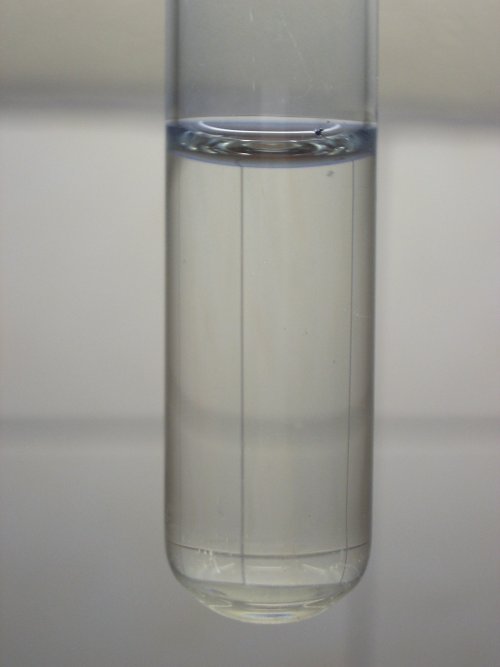
![]() When a small volume of a concentrated solution of sodium
hydroxide is added to the colorless liquid, then a bright yellow precipitate is
formed. This probably is hydrous copper (I) oxide. The yellow precipitate slowly
turns darker, while it settles on the bottom of the test tube. The copper (I)
compound is further reduced to metallic copper. The three pictures below show
the yellow precipitate, immediately after adding the solution of sodium
hydroxide, two minutes later and five minutes later.
When a small volume of a concentrated solution of sodium
hydroxide is added to the colorless liquid, then a bright yellow precipitate is
formed. This probably is hydrous copper (I) oxide. The yellow precipitate slowly
turns darker, while it settles on the bottom of the test tube. The copper (I)
compound is further reduced to metallic copper. The three pictures below show
the yellow precipitate, immediately after adding the solution of sodium
hydroxide, two minutes later and five minutes later.
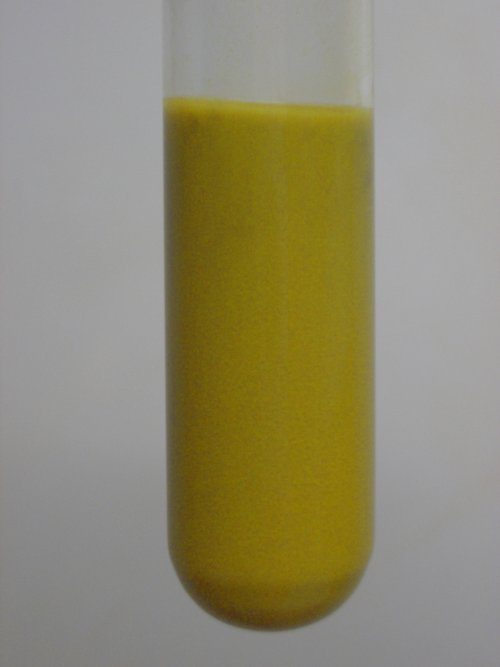
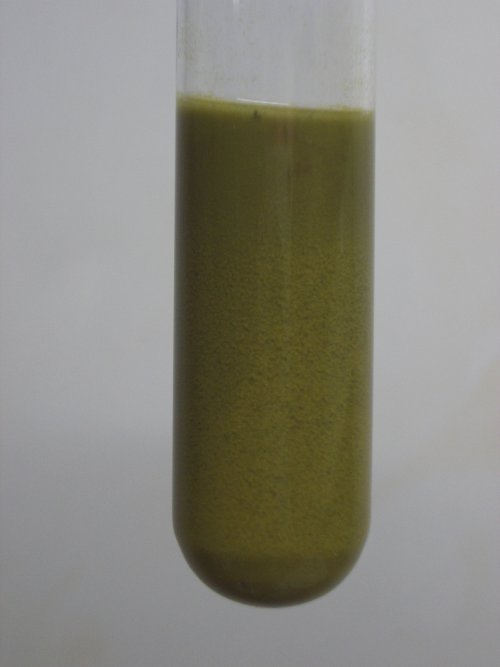
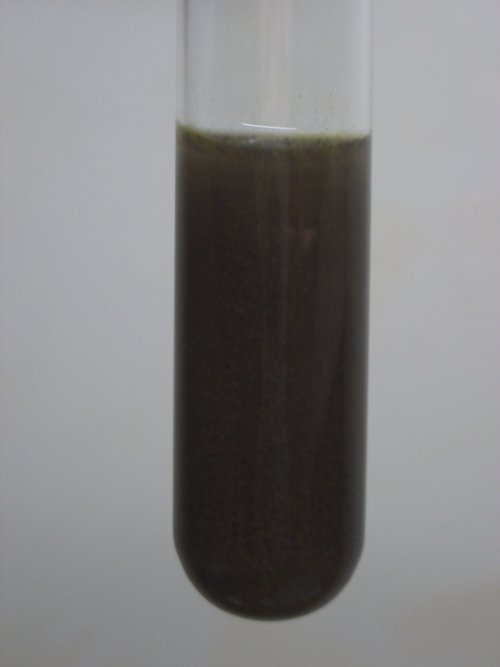
The three pictures below show the contents of the same test tube 10 minutes and 20 minutes after formation of the yellow precipitate. The rightmost picture also shows the test tube, with the light source behind the camera. The color is due to reflected light and this shows the nice red color of metallic copper. The glass of the test tube is covered by a very thin copper-mirror, which is bluish when viewed by transmitted light (left two pictures) and red/brown when viewed by reflected light.
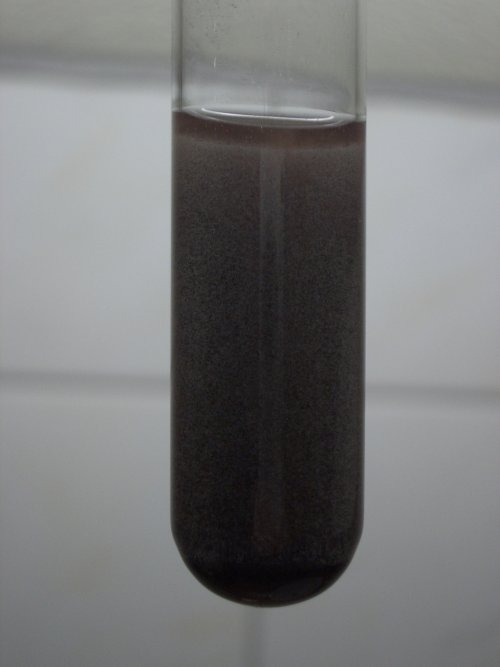
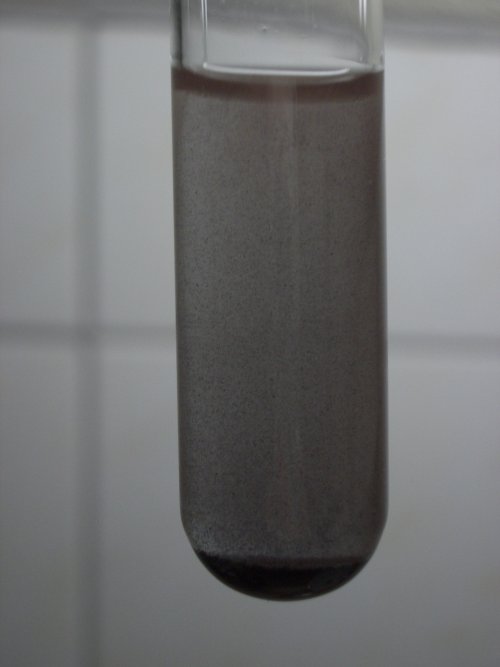
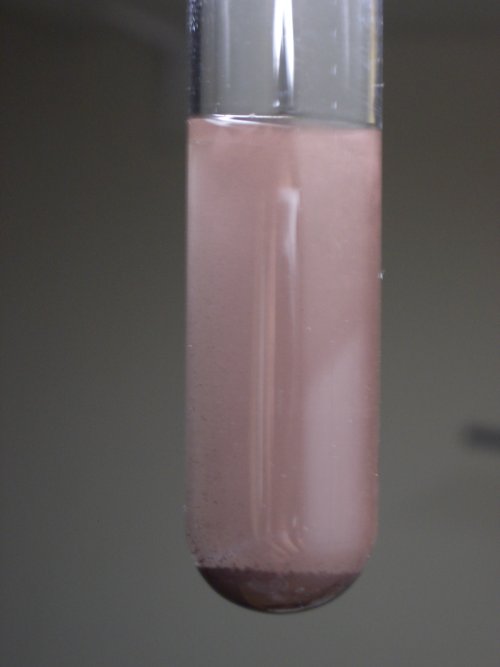
![]() This experiment with sodium dithionite shows that the
colorless ammonia-copper (I) complex is not stable in strongly alkaline
solutions.
This experiment with sodium dithionite shows that the
colorless ammonia-copper (I) complex is not stable in strongly alkaline
solutions.
![]()
Discussion of the results
![]() Copper (II) ions form a deep blue tetrammine complex in
excess ammonia. When a small amount of ammonia is added to a solution of an
aqueous copper (II) solution, then first copper (II) hydroxide is formed, which
on addition of more ammonia dissolves again on formation of the deep blue
tetrammine complex. The net reaction (not writing the aqua-ligands explicitly)
on addition of excess ammonia is:
Copper (II) ions form a deep blue tetrammine complex in
excess ammonia. When a small amount of ammonia is added to a solution of an
aqueous copper (II) solution, then first copper (II) hydroxide is formed, which
on addition of more ammonia dissolves again on formation of the deep blue
tetrammine complex. The net reaction (not writing the aqua-ligands explicitly)
on addition of excess ammonia is:
Cu2+(aq) + 4NH3(aq) → Cu(NH3)42+(aq)
The tetrammine complex is fairly stable, as long as the pH is not too low. At lower pH, it hydrolyses, forming hydrous copper (II) hydroxide and ammonium ion. The color of the Cu(NH3)42+(aq) ion is deep blue.
![]() With a sufficiently strong reductor, the following half
reaction occurs:
With a sufficiently strong reductor, the following half
reaction occurs:
Cu(NH3)42+(aq) + e → Cu(NH3)2+(aq) + 4NH3(aq)
The Cu(NH3)2+(aq) ion is colorless. This is what can be observed on addition of dithionite as strong reductor. The dithionite is oxidized to sulfite and sulfate. These reaction products do not interfere with the diammine copper (I) complex.
![]() The diammine copper (I) complex itself also is a fairly
strong reductor, which is easily oxidized by oxygen from the air. When some of
the colorless liquid is brought in contact with air, then the surface of the
liquid turns blue again, due to the reverse of the reaction, given above. With
excess of dithionite in solution, the blue color disappears again when the
liquid is shaken.
The diammine copper (I) complex itself also is a fairly
strong reductor, which is easily oxidized by oxygen from the air. When some of
the colorless liquid is brought in contact with air, then the surface of the
liquid turns blue again, due to the reverse of the reaction, given above. With
excess of dithionite in solution, the blue color disappears again when the
liquid is shaken.
![]() The Cu(NH3)2+(aq)
ion is not stable at very high pH. When pH goes close to 14, then the following
reaction occurs:
The Cu(NH3)2+(aq)
ion is not stable at very high pH. When pH goes close to 14, then the following
reaction occurs:
2Cu(NH3)2+(aq) + 2OH – (aq) → Cu2O(s, hydrous) + H2O + 4NH3(aq)
The solid hydrous Cu2O is yellow. With the excess dithionite ions in solution, this is reduced further to metallic copper. This at first makes the precipitate darker and finally results in formation of a 'heavy' brown precipitate.
Remaining open questions on the experiment with sulfite
The experiment with the sulfite shows formation of a very dark blue complex, even darker than the tetrammine copper (II) complex. What is the composition of this complex? The ammonia plays an important role. Without ammonia, a copper (II) solution forms a green precipitate with sulfite, which slowly turns yellow, indicating reduction to copper (I).
This complex also has a reversible temperature dependent color. The hot solution is green, the cold solution is blue. A similar effect is known from cobalt (II) chloride in excess chloride, which is deep blue, when hot and pink, when cold.
Remaining open questions on the experiment with ascorbate
The experiment with the ascorbate shows formation of a bright yellow compound. Is this a complex with copper (I) and ascorbate or its oxidation product, or is this simply the color of the oxidation product of ascorbate?
The result of this experiment is quite remarkable, because of the deep yellow color, which is quite uncommon for copper compounds.